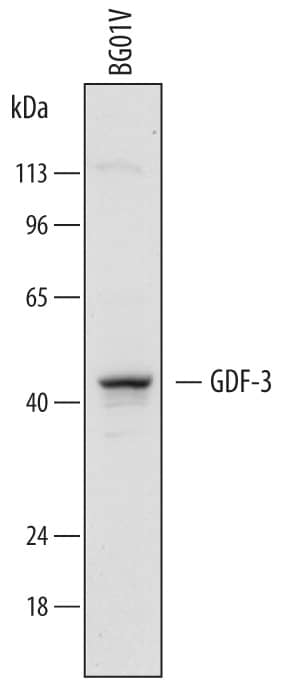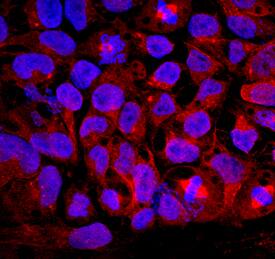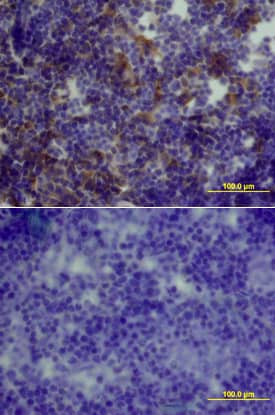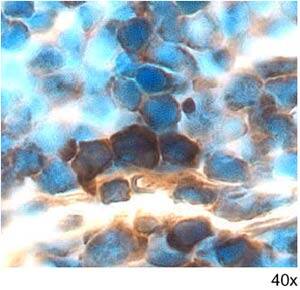Human/Mouse GDF-3 Antibody
R&D Systems, part of Bio-Techne | Catalog # AF958


Key Product Details
Species Reactivity
Validated:
Cited:
Applications
Validated:
Cited:
Label
Antibody Source
Product Specifications
Immunogen
Ala253-Gly366
Accession # Q07104
Specificity
Clonality
Host
Isotype
Scientific Data Images for Human/Mouse GDF-3 Antibody
Detection of Human GDF‑3 by Western Blot.
Western blot shows lysates of BG01V human embryonic stem cells. PVDF membrane was probed with 1.5 µg/mL of Goat Anti-Human/Mouse GDF-3 Antigen Affinity-purified Polyclonal Antibody (Catalog # AF958) followed by HRP-conjugated Anti-Goat IgG Secondary Antibody (Catalog # HAF017). A specific band was detected for GDF-3 at approximately 42 kDa (as indicated). This experiment was conducted under reducing conditions and using Immunoblot Buffer Group 1.GDF‑3 in BG01V Human Stem Cells.
GDF-3 was detected in immersion fixed BG01V human embryonic stem cells using Goat Anti-Human/Mouse GDF-3 Antigen Affinity-purified Polyclonal Antibody (Catalog # AF958) at 10 µg/mL for 3 hours at room temperature. Cells were stained using the NorthernLights™ 557-conjugated Anti-Goat IgG Secondary Antibody (red; Catalog # NL001) and counterstained with DAPI (blue). Specific staining was localized to cytoplasm. View our protocol for Fluorescent ICC Staining of Cells on Coverslips.GDF‑3 in Mouse Thymus.
GDF-3 was detected in perfusion fixed frozen sections of mouse thymus using Mouse GDF-3 Antigen Affinity-purified Polyclonal Antibody (Catalog # AF958) at 15 µg/mL overnight at 4 °C. Tissue was stained using the Anti-Goat HRP-DAB Cell & Tissue Staining Kit (brown; Catalog # CTS008) and counterstained with hematoxylin (blue). Lower panel shows a lack of labeling if primary antibodies are omitted and tissue is stained only with secondary antibody followed by incubation with detection reagents. View our protocol for Chromogenic IHC Staining of Frozen Tissue Sections.Applications for Human/Mouse GDF-3 Antibody
Immunocytochemistry
Sample: Immersion fixed BG01V human embryonic stem cells
Immunohistochemistry
Sample: Perfusion fixed frozen sections of mouse thymus
Western Blot
Sample:
BG01V human embryonic stem cells
Formulation, Preparation, and Storage
Purification
Reconstitution
Formulation
Shipping
Stability & Storage
- 12 months from date of receipt, -20 to -70 °C as supplied.
- 1 month, 2 to 8 °C under sterile conditions after reconstitution.
- 6 months, -20 to -70 °C under sterile conditions after reconstitution.
Background: GDF-3
GDF-3 (previously called Vgr-2) is a TGF-beta superfamily member belonging to the growth/differentiation factor family (1, 2). GDF-3 is expressed in undifferentiated embryonic stem (ES) cells, adipose tissue and the brain (2-4). In ES cells, it maintains pluripotency and influences early cell fate decisions (5, 6). For example, frog embryos injected with GDF-3 develop a secondary dorsal axis and deletion of mouse GDF-3 can produce defects in the anterior visceral endoderm of the pre‑gastrulation embryo (5, 6). In adipocytes, GDF-3 is induced by a high fat diet and promotes adipogenesis (3). GDF-3 has been reported to oppose BMP’s functions and to have a nodal-like activity in early development (1). The 366 amino acid (aa) mouse GDF-3 contains a 22 aa signal sequence, a 230 aa propeptide and a 114 aa mature protein that contains one potential N-glycosylation site. Most of GDF-3 is present as the prepro form, while the mature GDF-3 is presumably the secreted, active form (1). The mature protein contains the cysteine-knot structure that is conserved throughout family members. Since it lacks the fourth cysteine, which is responsible for the formation of inter-molecular disulfide bond, GDF-3 may exist as a non-covalent homodimer. Mature mouse GDF-3 shares 90%, 83%, and 83% aa identity with rat, human and canine GDF-3, respectively. Among family members, mature GDF-3 is most similar to mouse BMP-6 (45% aa identity) and Xenopus VG‑1 (52% aa identity).
References
- Levine, A.J. and A.H. Brivanlou (2006) Cell Cycle 5:1069.
- McPherron, A.C. and S-J. Lee (1993) J. Biol. Chem. 268:3444.
- Wang, W. et al. (2004) Biochem. Biophys. Res. Comm. 321:1024.
- Hexige, S. et al. (2005) Neurosci. Lett. 389:83.
- Levine, A.J. and A.H. Brivanlou (2005) Development 133:209.
- Chen, C. et al. (2006) Development 133:319.
Long Name
Alternate Names
Gene Symbol
UniProt
Additional GDF-3 Products
Product Documents for Human/Mouse GDF-3 Antibody
Product Specific Notices for Human/Mouse GDF-3 Antibody
For research use only


